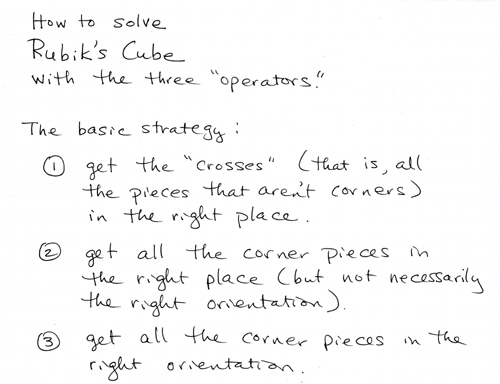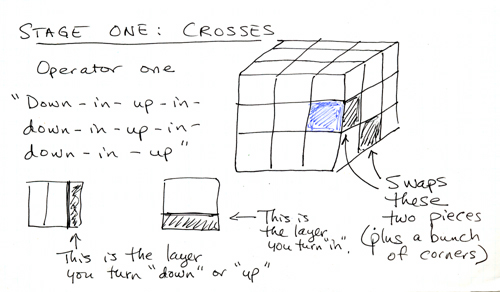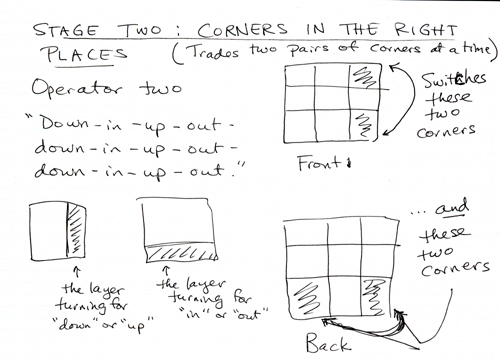Yesterday, one of the elder Free-Ride offspring’s teammates brought a Rubik’s Cube to soccer practice. While this youngster fiddled with the cube during a water break, I mentioned that I knew how to solve it. I was asked to transmit this knowledge, and I promised to write it up and send it to the player at this morning’s soccer match.
And I thought, “You know, there are probably others who might like this information.” So I made a quick detour to the scanner, and am sharing the very same information with you all.
I’m pretty sure that revealing this knowledge won’t get me drummed out of the Nerds’ Alliance, but I guess we’ll see.




You have to mess around with these operators on your cube for a while before you really have a feel for how they work. Also, in the interests of full disclosure, I did not develop these operators myself. I learned them from a friend at math camp in 1981, and she learned them from a friend at her school, if I recall correctly.

That’s far too complicated. My system involves just two steps:
1. Peal off colored squares
2. Re-apply colored squares in correct orientation
Peeling off the stickers and reapplying them is much too time consuming and doesn’t work after numerous times.
You can pry the cube apart and re-assemble it in the proper positions. You only need to be careful of the gooey lubricant they use on the inside.
I was shocked and thrilled to learn that all the kids in my cousin’s sixth grade class are playing with their Rubik’s Cubes during recess these days (in fact they’re now messaging each other with similarly scrawled and sketched solutions to the cube).
I wish I were a kid in that class. When I was in sixth grade (almost 20 years ago, geesh), kickball was the name of the game. A chubby, asthmatic academic (ie nerd) like myself would have had a strong preference for Rubik’s cubing. As it was, balls bounced off my head in failed catch attempts or slipped under my feet in failed kick attempts, and more often than I care to admit, I bounced to or slid along the ground.
The rubiks cube is a great icebreaker especially when you take public transport on a daily basis which is what I do. Not to mention happy hour. God knows how many people bought me free drinks because they couldn’t believe I could finish it.
Though, we all start with the cross technique. A faster (though not necessarily better) way would be to solve it via 2x2x2, then 2x2x3, then 2x3x3 then finish it with orientating the final edges and the corners. I shaved off a good 30 seconds that way.
I’ve always been partial to the “layered” method myself; you get one side totally solved, which is your first layer. After that, you get the corner pieces that make up the second layer, and finish it in much the same way Edrei does.
Using a solution sheet is cheating or at least depriving of the challenge. When I got my first cube, my friend who knew how to solve it would not give me the solution until I had solved it at least once on my own. I still have the sheet from a spiral bound notebook that he gave me; I encapsulated it in preservation class many years later(luckily it was written on only one side so that I could encapsulate it with a sheet of buffered paper to slow the “stewing in it’s own juices” problem) still looked pretty good last time I looked at it. This solution has you complete one side, then get all the corners, solve the opposite side, and finally fix the one or two center pieces that remain. My first cube has a black side instead of a red one because my brother tried the peel method. And someone broke my 4×4 which I’ve never replaced. I have a couple promotional cubes from Adobe which are a bear to solve because the images they used instead of colors are not sufficiently different.